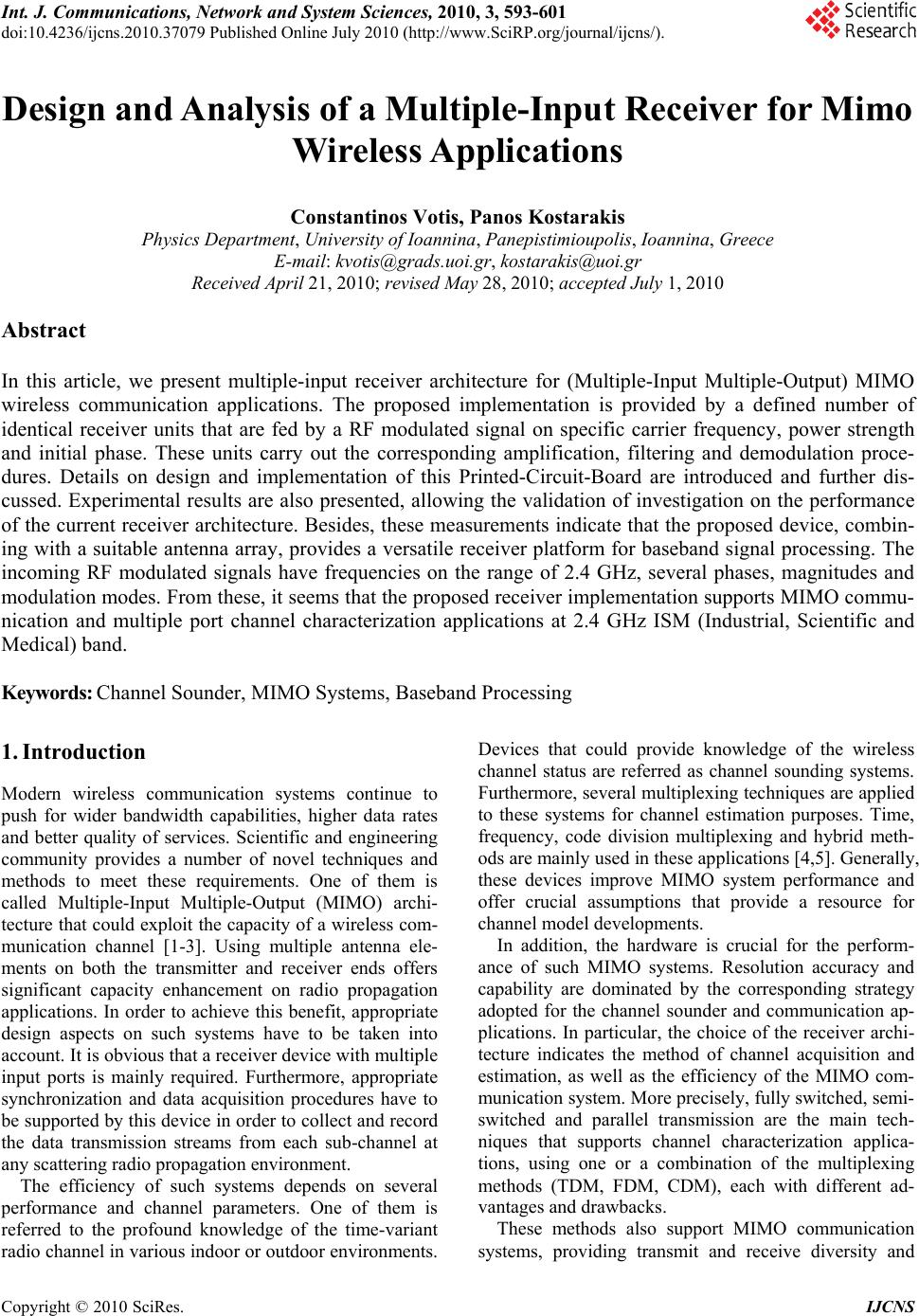
Int. J. Communications, Network and System Sciences, 2010, 3, 593-601
doi:10.4236/ijcns.2010.37079 Published Online July 2010 (http://www.SciRP.org/journal/ijcns/).
Copyright © 2010 SciRes. IJCNS
Design and Analysis of a Multiple-Input Receiver for Mimo
Wireless Applications
Constantinos Votis, Panos Kostarakis
Physics Department, University of Ioannina, Panepistimioupolis, Ioannina, Greece
E-mail: kvotis@grads.uoi.gr, kostarakis@uoi.gr
Received April 21, 2010; revised May 28, 2010; accepted July 1, 2010
Abstract
In this article, we present multiple-input receiver architecture for (Multiple-Input Multiple-Output) MIMO
wireless communication applications. The proposed implementation is provided by a defined number of
identical receiver units that are fed by a RF modulated signal on specific carrier frequency, power strength
and initial phase. These units carry out the corresponding amplification, filtering and demodulation proce-
dures. Details on design and implementation of this Printed-Circuit-Board are introduced and further dis-
cussed. Experimental results are also presented, allowing the validation of investigation on the performance
of the current receiver architecture. Besides, these measurements indicate that the proposed device, combin-
ing with a suitable antenna array, provides a versatile receiver platform for baseband signal processing. The
incoming RF modulated signals have frequencies on the range of 2.4 GHz, several phases, magnitudes and
modulation modes. From these, it seems that the proposed receiver implementation supports MIMO commu-
nication and multiple port channel characterization applications at 2.4 GHz ISM (Industrial, Scientific and
Medical) band.
Keywords: Channel Sounder, MIMO Systems, Baseband Processing
1. Introduction
Modern wireless communication systems continue to
push for wider bandwidth capabilities, higher data rates
and better quality of services. Scientific and engineering
community provides a number of novel techniques and
methods to meet these requirements. One of them is
called Multiple-Input Multiple-Output (MIMO) archi-
tecture that could exploit the capacity of a wireless com-
munication channel [1-3]. Using multiple antenna ele-
ments on both the transmitter and receiver ends offers
significant capacity enhancement on radio propagation
applications. In order to achieve this benefit, appropriate
design aspects on such systems have to be taken into
account. It is obvious that a receiver device with multiple
input ports is mainly required. Furthermore, appropriate
synchronization and data acquisition procedures have to
be supported by this device in order to collect and record
the data transmission streams from each sub-channel at
any scattering radio propagation environment.
The efficiency of such systems depends on several
performance and channel parameters. One of them is
referred to the profound knowledge of the time-variant
radio channel in various indoor or outdoor environments.
Devices that could provide knowledge of the wireless
channel status are referred as channel sounding systems.
Furthermore, several multiplexing techniques are applied
to these systems for channel estimation purposes. Time,
frequency, code division multiplexing and hybrid meth-
ods are mainly used in these applications [4,5]. Generally,
these devices improve MIMO system performance and
offer crucial assumptions that provide a resource for
channel model developments.
In addition, the hardware is crucial for the perform-
ance of such MIMO systems. Resolution accuracy and
capability are dominated by the corresponding strategy
adopted for the channel sounder and communication ap-
plications. In particular, the choice of the receiver archi-
tecture indicates the method of channel acquisition and
estimation, as well as the efficiency of the MIMO com-
munication system. More precisely, fully switched, semi-
switched and parallel transmission are the main tech-
niques that supports channel characterization applica-
tions, using one or a combination of the multiplexing
methods (TDM, FDM, CDM), each with different ad-
vantages and drawbacks.
These methods also support MIMO communication
systems, providing transmit and receive diversity and